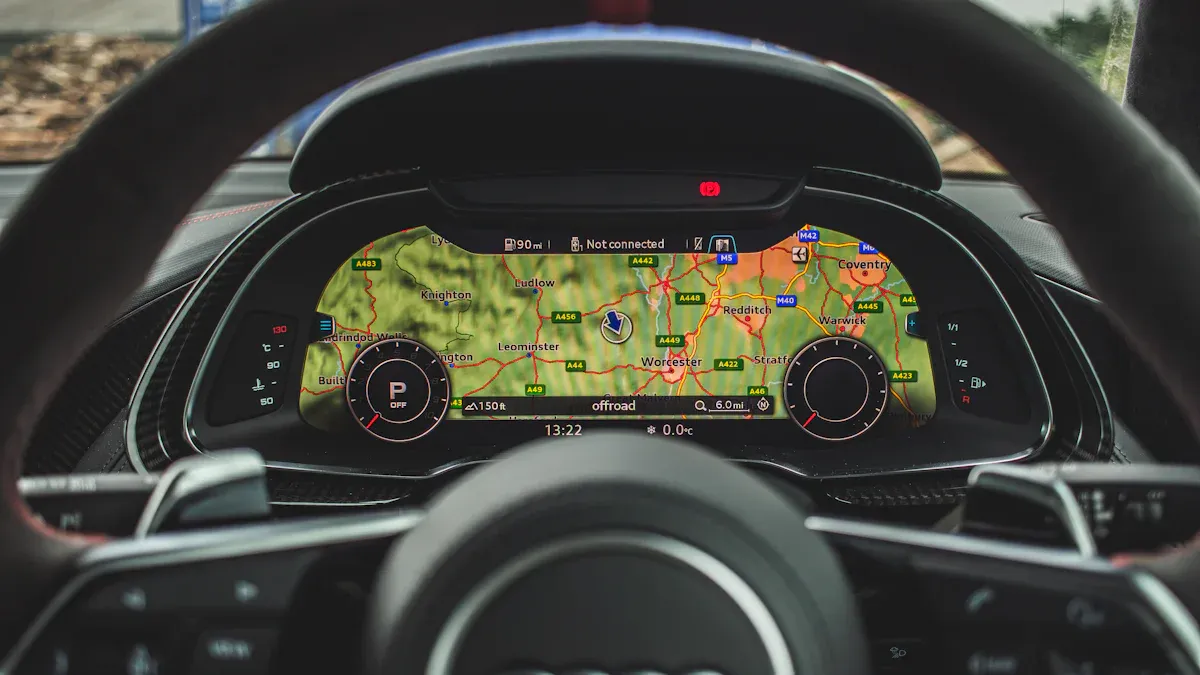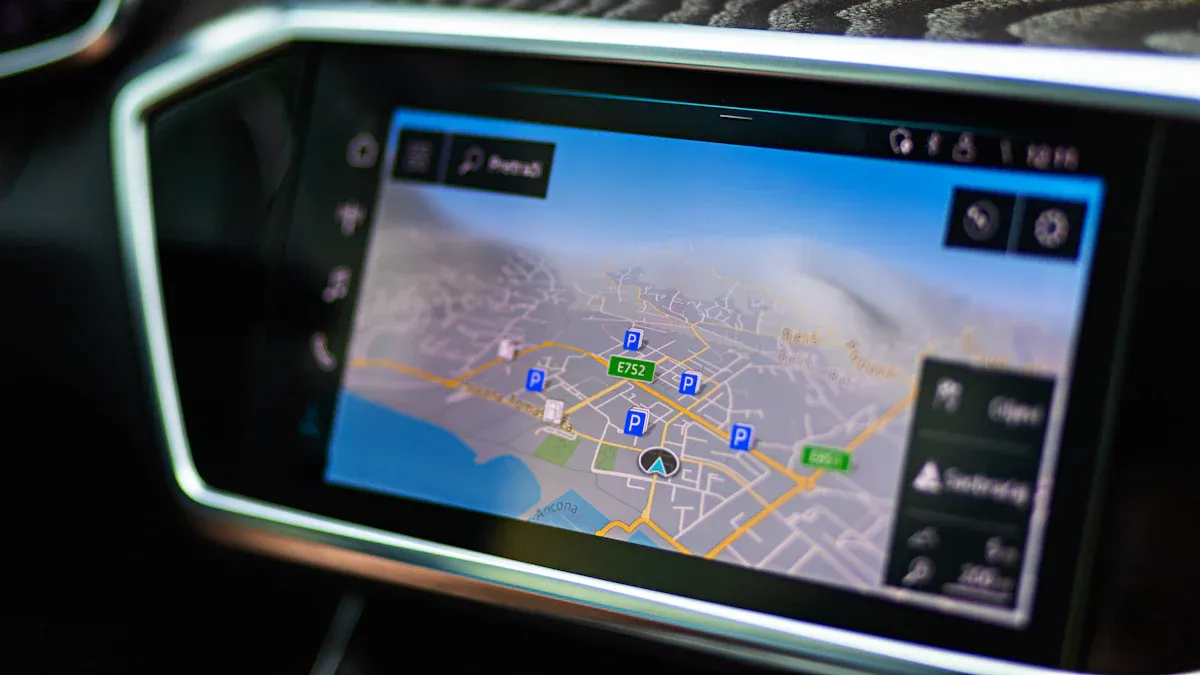
You want your car ads to reach the right people at the right time. With a автомобильный рекламный плеер с GNSS-идентификацией местоположения, you can do just that. Here’s how real-time location data and geofencing change the game:
Your system collects location data from mobile devices.
It sets up virtual boundaries around places like dealerships.
Ads appear when someone enters or leaves these zones.
People get offers that match their interests and behavior.
You see more clicks, higher engagement, and a real boost in sales.
Tip: When you use these features, you not only improve your ROI but also give customers a more personal experience.
Key Takeaways
Use GNSS-based location data to show car ads where your best customers drive. This helps more people see and like your ads. It can also help you sell more cars.
Set up geofences around important places like dealerships. This lets you send offers at the right time. These offers are helpful and make customers trust you more.
Split your audience by how they drive and what they like. This way, you can show ads that fit what each person wants.
Change your ads quickly by using live data and AI tools. This keeps your ads new and helps more people click on them.
Follow privacy laws and ask for user consent. This helps people trust you. Use smart technology to save money and get the most from your ad budget.
Location-Based Ad Delivery

Location Targeting
You want your ads to reach the right people. Location targeting helps you do this. With GNSS-based car ad players, you can show ads in certain places. Drivers or passengers see ads in specific areas. You can focus on neighborhoods, cities, or even streets.
You can split your audience by where they are. You can also use what they do or who they are. For example, if you sell luxury cars, target people in fancy neighborhoods. If you own a dealership, reach people near your lot. You can also reach people close to your competitors.
Tip: Send notifications when people are likely to respond. For example, send a lunch deal when someone drives by your restaurant at noon.
Here are some ways to use location targeting:
Show ads only in places where your best customers drive.
Change your message based on the time or local events.
Use creative offers that fit people’s needs in each place.
Always get user consent before collecting location data.
Real brands use these ideas every day. Uber tells riders about surge pricing in busy spots. Pokemon GO gives rewards for exploring new places. You can use these ideas to make your car ads stand out.
Geofencing Strategies
Geofencing lets you draw fake borders on a map. When someone enters or leaves, your ad player can send a message or offer. This tool helps you reach people at the best time.
To get the best results, follow these tips:
Make your geofences the right size. Not too big or too small. You do not want to miss good customers or bother the wrong people.
Always ask for user permission. Tell people how you use their location. Explain the benefits. This builds trust and keeps people happy.
Change your messages. Think about where the user is and what time it is. A coffee shop can send a morning deal when someone drives by before work.
Test and improve your campaigns. Watch your click rates and conversions. Change your geofence or message if you see low results.
Try geo-conquesting. Target people near your competitors. For example, send a special offer to drivers near another dealership.
Balance engagement and privacy. Do not send too many notifications. Too many alerts can make people delete your app.
Follow privacy laws like GDPR. Always respect user data and follow the rules.
Note: Starbucks sends special offers to people near their stores. Target uses in-store deals triggered by geofencing. These brands show how well this strategy works.
When you use geofencing the right way, everyone wins. Customers get good offers at the right time. You get better results and more value from your ads.
Data-Driven Campaign Optimization
Audience Segmentation
You want your ads to speak to the right people. Audience segmentation helps you do that. With GNSS-based car ad players, you can group your audience by where they go, what they like, and how they behave. This means you can show different ads to different people, even if they are in the same area.
Let’s say you run a car dealership. You can split your audience into groups like:
People who drive by your lot every day
Shoppers who visit your competitors
Families who travel to schools or parks
Commuters who pass through busy highways
When you know who is in each group, you can send messages that match their needs. For example, you might show a family-friendly SUV ad to parents near a school. You might show a trade-in offer to someone who visits other dealerships.
Tip: Use data from your GNSS system to spot patterns. Look for trends in driving routes, visit times, and favorite locations. This helps you build better segments.
A big study looked at millions of car ad campaigns. It found that when you use data to segment your audience, you get more conversions and waste less money. You can balance your ads across different channels and make sure each group sees the right message. This makes your campaigns work better and saves you time and budget.
Here’s a simple table to help you think about segments:
Segment Type | Example Location | Best Ad Message |
|---|---|---|
Daily Commuters | Main highways | Gas-saving car deals |
Family Travelers | Near schools/parks | Safe, roomy vehicles |
Dealership Visitors | Near your lot | Test drive offers |
Competitor Shoppers | Near rival dealers | Trade-in bonuses |
Real-Time Adjustments
You can make your ads even smarter by changing them in real time. GNSS-based systems let you see what’s happening right now. You can adjust your ads based on live data, like traffic jams, weather, or local events.
Imagine a rainy day. You can switch your ad to show a special on all-wheel-drive cars. If there’s a big event downtown, you can promote parking deals or shuttle services. You don’t have to wait for next week’s report. You can act now.
AI-powered tools make this even easier. They watch how people respond to your ads and run tests automatically. If one ad gets more clicks, the system shows it more often. This kind of smart adjustment can boost your engagement rates by up to 50%. Some dealerships have seen their click-through rates jump by 15-20% just by using real-time data and AI.
Note: When you use real-time adjustments, you keep your ads fresh and relevant. People notice when you respond to what’s happening around them.
You can also use automated A/B testing. The system tries out two versions of an ad and picks the winner. This happens while your campaign is running, so you don’t waste time or money on ads that don’t work.
Here’s how you can use real-time adjustments:
Watch your dashboard for live data.
Change your ad message based on weather, traffic, or events.
Let AI tools test and pick the best ads.
Adjust your budget to focus on high-performing segments.
Keep your content up to date so people always see something new.
When you combine smart audience segmentation with real-time adjustments, your car ad campaigns become powerful. You reach the right people, at the right time, with the right message. That’s how you win in today’s fast-moving world of automotive advertising.
Performance and Analytics
Measuring ROI
You want to know if your car ad campaigns really work. That’s where ROI, or return on investment, comes in. ROI tells you how much money you make compared to what you spend. If you use a GNSS-based car ad player, you can track this easily.
Here’s a simple way to look at ROI:
What You Spend | What You Earn | ROI Formula |
|---|---|---|
$1,000 | $2,500 | ($2,500 – $1,000) / $1,000 = 1.5 or 150% |
You can use this formula for each campaign. If you spend $1,000 and earn $2,500, your ROI is 150%. That means you made more than you spent. You can check these numbers in your ad dashboard.
Tip: Always compare your ROI for different locations and times. You might find that ads near busy malls work better than ads on quiet streets.
You can also look at cost per click (CPC) and cost per action (CPA). These numbers show how much you pay for each click or sale. Lower numbers mean your ads work well.
Engagement Metrics
ROI is important, but you also want to see how people interact with your ads. Engagement metrics help you do this. These numbers show if people notice, click, or act on your ads.
Here are some key metrics to watch:
Impressions: How many times people see your ad.
Clicks: How many people tap or click your ad.
Click-Through Rate (CTR): Clicks divided by impressions. Higher is better.
Conversions: How many people take action, like booking a test drive.
Dwell Time: How long people look at your ad.
Note: If your CTR goes up after you change your ad, you know your new message works.
You can set goals for each metric. For example, you might want a CTR of 2% or more. Watch your dashboard every week. Try new ideas if your numbers drop. This way, you keep your campaigns strong and your audience interested.
Technology Integration

Автомобильный рекламный плеер с GNSS-идентификацией местоположения
If you pick an автомобильный рекламный плеер с GNSS-идентификацией местоположения, you want good hardware and software. The right setup helps your ads reach drivers at the best time. Not every player is built the same way. Some have better accuracy, safety, or extra features.
Here are things to check before you choose an автомобильный рекламный плеер с GNSS-идентификацией местоположения:
Requirement Category | Details |
|---|---|
Hardware | GNSS receiver/chipset (ISO 26262), connects with sensors like IMUs and odometers |
Software | ASIL-B ready engine, advanced algorithms, manages risk and accuracy |
Safety Compliance | ISO 26262, ISO/PAS 21448 |
Security Compliance | ISO 21434, anti-spoofing, anti-jamming |
Quality Standards | A-SPICE CL3, real-world testing |
Performance | |
Integration | Works with ADAS and autonomous driving systems |
A great example is the Blackview N6000. This автомобильный рекламный плеер с GNSS-идентификацией местоположения works with GPS, GLONASS, Beidou, and Galileo. It uses Android, has a bright screen, and connects to WiFi, Bluetooth, and 4G. You get fingerprint unlock, NFC, and a strong battery. These features help your ads run well and stay safe.
Tip: Always make sure your автомобильный рекламный плеер с GNSS-идентификацией местоположения follows safety and security rules. This keeps your data safe and your ads working.
GNSS and INS Combination
You want your автомобильный рекламный плеер с GNSS-идентификацией местоположения to work everywhere, even in tunnels or cities with tall buildings. GNSS gives you global location, but sometimes the signal is weak. INS (Inertial Navigation System) helps when this happens.
INS uses sensors like accelerometers and gyroscopes. These sensors track your car’s movement, speed, and direction. If GNSS signals drop, INS keeps your position updated. When you use both GNSS and INS, your автомобильный рекламный плеер с GNSS-идентификацией местоположения stays accurate and reliable.
GNSS gives you your exact global position.
Together, they fix each other’s weak points.
Your ads reach drivers in the right place, every time.
Many companies use both systems. For example, SBG Systems makes devices that keep ads accurate, even in hard places. Their systems use both GNSS and INS for very good precision. This means your автомобильный рекламный плеер с GNSS-идентификацией местоположения can always find the right people, no matter where the car goes.
Compliance and Cost Efficiency
Data Privacy
You want your customers to trust you with their data. When you use GNSS-based car ad players, you collect location information. This means you must follow strict privacy rules. The European GDPR sets the standard for how you handle this data. You need to get clear consent from users before you collect or use their location. Always tell people what data you collect, why you need it, and how you will use it.
Here are some key privacy steps you should follow:
Keep records of all data processing activities.
Use privacy by design and default in your systems.
Run data protection impact assessments when needed.
Make sure you have a legal reason for collecting data, like user consent.
Give users full details about your privacy policy in simple language.
Protect data from being linked back to a person unless you have permission.
When you show your privacy policy in a clear way, people trust you more. They feel safer and are more likely to accept your ads. Strong privacy practices also make your brand look better. If you respect privacy, users see your ads as less intrusive and may even buy more from you.
Tip: Always balance personalized ads with respect for privacy. This helps you build long-term trust and keeps your campaigns running smoothly.
Cost-Effective Solutions
You want to save money while reaching more people. Smart strategies can help you lower costs and boost results. For example, using programmatic SEO and Google Ads optimization can cut your ad costs and bring in more leads. Here’s a quick look at what works:
Strategy Category | Tactics | Impact on Cost Savings |
|---|---|---|
SEO Efforts | Long-tail keywords, guest posts, blogging | |
Google Ads Optimization | Better ad copy, keyword testing, A/B testing | 44% lower cost-per-acquisition (CPA) |
You can also save money by working with car makers and telecom companies. This lets you share the cost of GNSS technology. Try using low-cost GNSS chips and free correction services like Galileo HAS. Hybrid GNSS and sensor modules cost less than $10 and give you great accuracy.
Use cloud-based services to avoid high equipment costs.
Pick affordable hardware for emerging markets.
Add value with extra features, not just basic tracking.
By following these tips, you keep your costs low and your campaigns strong. You reach more drivers without breaking your budget.
You now have the tools to make your car ad campaigns smarter. Use real-time GNSS data, set up geofences, and track your results with analytics. These steps help you reach the right people and boost your ROI.
Try these strategies today to see quick wins.
Want to learn more? Check out guides on GNSS tech or talk to a digital ad expert.
Ready to take your car ads to the next level? Start now and watch your results grow!
FAQ
How does a GNSS-based car ad player know where I am?
Your car ad player uses satellites to find your location. It checks your position in real time. This helps it show ads that match where you are right now.
Is my location data safe with these systems?
Yes, your data stays safe if you use trusted systems. Good ad players follow privacy laws. They ask for your permission and protect your information from hackers.
Can I turn off location tracking if I want?
You can turn off location tracking anytime. Just go to your device settings and switch off location services. The ad player will stop collecting your location.
What happens if the GNSS signal is weak or lost?
If the signal drops, the system uses sensors inside your car. These sensors help keep track of your location until the signal comes back.
Will I get too many ads while driving?
No, you will not get flooded with ads. Smart ad players limit how many ads you see. They send messages only when they matter most.
See Also
How G37 Apple CarPlay Adapters Transform Your Driving Experience
Key Innovations Driving The Future Of Android Auto Wireless
Best Ten Wireless Apple CarPlay Adapters To Watch In 2025
Leading Ten Wireless CarPlay Adapters Expected In 2025
Top Wireless CarPlay Adapters Ensuring Smooth And Easy Driving
